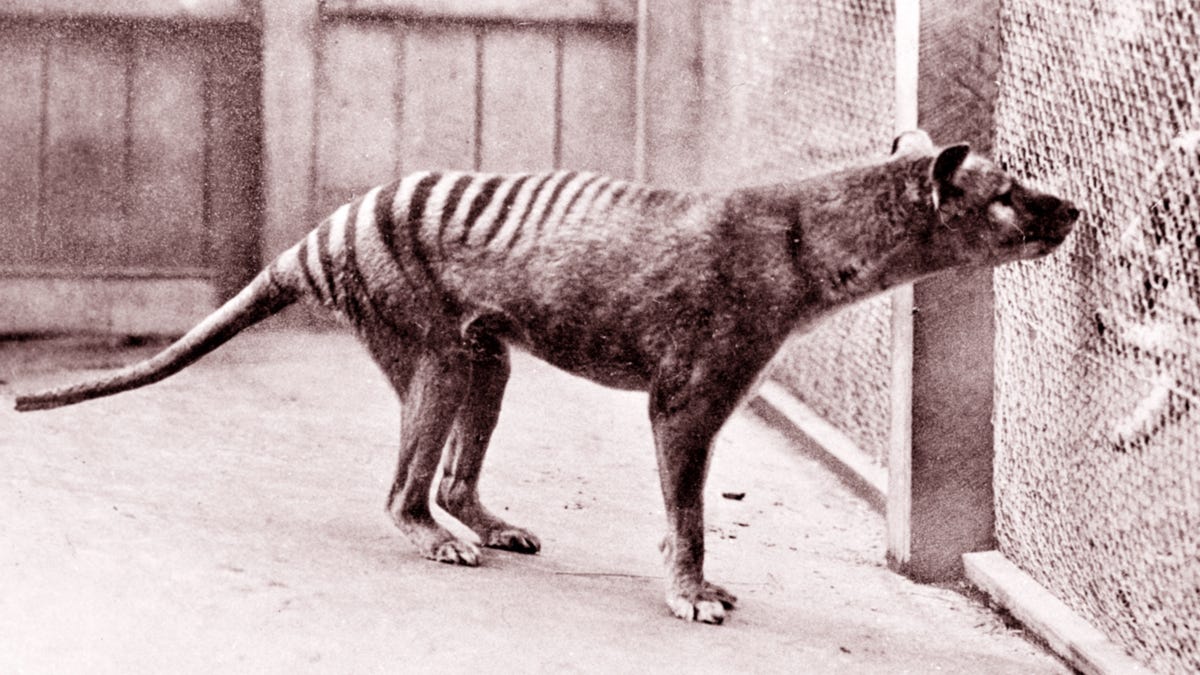Australian Scientists Plan to Resurrect the Extinct Tasmanian Tiger
An ambitious new project aims to bring an iconic marsupial species back from the dead.

The Tasmanian tiger, or thylacine, is one of Australia's most iconic species. Even though it has been extinct since 1936, the slender, striped marsupial maintains its place in Australian mythology because of a constant string of supposed sightings that has captivated the public and the media. Just last year, one group claimed to have spotted the "Tassie tiger" padding through Australia's forests. The claims were never verified.
Sadly, the Tasmanian tiger is gone -- but with advances in biotechnology, that might not have to be the case.
A group of researchers from the University of Melbourne plan to bring the Tasmanian tiger back from the dead. On March 1, they announced the creation of the Thylacine Integrated Genetic Restoration Research (TIGRR) Lab, thanks to a $3.6 million ($5 million AUD) philanthropic donation.
Andrew Pask, a marsupial evolutionary biologist and Tasmanian tiger expert at the University of Melbourne, will lead the project. He notes that yes, the grand challenge of the research is to bring back the Tasmanian tiger from the dead. However, while that is the headline goal, the biotechnology that will be developed along the way is critical for marsupial conservation efforts today.
"It's not all Jurassic Park and, you know, 'we shouldn't be playing God'," says Pask. "We actually need a lot of this stuff for protecting marsupials right now."
There have been calls to resurrect the Tasmanian tiger for over two decades. In 1999, paleontologist Michael Archer took over as director of the Australian Museum and committed around $57 million to a project that hoped to clone the iconic marsupial from old specimens. It was called a "fantasy" at the time and by 2005, it was canned.
Since then, two decades of breakthroughs in gene editing have allowed scientists to dream big about "de-extinction," the process of bringing extinct species back from the dead. The major revolution is thanks to CRISPR, a powerful DNA cut-and-paste tool, which presents a way for scientists to recreate the genetic code of species long extinct.
The technology is at the heart of a proposal to bring back the Woolly Mammoth by 2027, led by the biotech firm Colossal. In September, the company announced it had received $15 million in funding and would attempt to have the first calves in "four to six years" and rewild herds of mammoth into the Arctic.
Decoding the Thylacine
Bringing back a species would require understanding its DNA code, from start to finish.
Scientists would then be able to take cells from a related species and use CRISPR to change that code. For instance, the Tasmanian tiger is related to another marsupial species, the mouse-like dunnart. "It turns out the dunnart is pretty much the closest thing to a thylacine of any living marsupial," he says.
Starting with a dunnart cell, you can edit in all of the DNA differences to turn it into a Tasmanian tiger. Think of it like turning a copy of Harry Potter and the Sorcerer's Stone into a copy of Harry Potter and the Chamber of Secrets. You can leave some of the words, characters, sentences intact, but you're going to need to rejig and reorder the text so it becomes a completely different book.
The first step is complete. Pask's group was able to decode the full genome of the Tasmanian tiger in a study published in Nature Ecology & Evolution back in 2017. However, the work needed to mould one species into another is still at least a decade away, Pask estimates. "It is dependent on leaps in that technology over the next few years," he says.
The point of starting the TIGRR Lab is to use gene editing techniques developed at places like Colossal to make more immediate gains in marsupial gene editing, Pask adds.
He speaks specifically to one project: Gene editing in the quoll, an endangered species of carnivorous marsupial. Quoll numbers have declined dramatically across Australia thanks to urbanization and the invasive cane toad. Quolls love to feed on the toads, but the toad's poison can kill them, posing a major threat to the species survival.
Some of the techniques developed on the way to Tasmanian tiger de-extinction could allow researchers to engineer resistance to cane toad toxins in the quoll population.
Resurrecting the Dead
De-extinction projects have drawn the ire of some conservation researchers, who have suggested spending big dollars on bringing animals back from the dead could actually result in a loss of biodiversity.
The argument against bringing species back is that there's a significant cost involved in maintaining the populations. For Pask at least, the Tasmanian tiger is a special case with obvious benefits. The environment it lived in 90 years ago hasn't changed all that much and it was the apex predator of its time. You could slot it back into the environment, he suggests, and immediately see the benefits.
It wouldn't be as simple as just breeding and dropping off baby tigers though. It's likely such a project would require intense monitoring and maintenance and the effects on the overall ecosystem are hard to predict. Understanding the complexities and the interplay between species is a key consideration – and any intervention would need to be discussed with stakeholders.
Will we see Tasmanian tigers roaming Australia in the next decade? It's hard to say. The pedigree of Pask's laboratory and the funding certainly puts humanity on the path to such a future. The biotechnological advances in gene editing demonstrate that we've entered a new reality where science has the power to manipulate DNA in a way that can, in theory, bring back extinct species.
As I wrote in 2019: With our power over the genome increasing every day, the question is no longer "can we resurrect the dead?" but "should we?"

